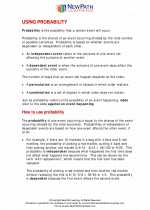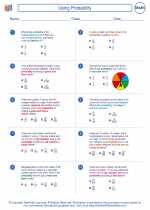Probability Study Guide
What is Probability?
Probability is the measure of the likelihood that an event will occur. It is expressed as a number between 0 and 1, where 0 indicates impossibility and 1 indicates certainty. The formula for probability is:
\[ P(A) = \dfrac{n(A)}{n(S)} \]
Where:
- \( P(A) \) = Probability of event A
- \( n(A) \) = Number of favorable outcomes
- \( n(S) \) = Total number of possible outcomes
Types of Probability
- Theoretical Probability:
- This is based on what is expected to happen.
- Example: Theoretical probability of rolling a 5 on a fair six-sided die is \( \dfrac{1}{6} \).
- Experimental Probability:
- This is based on actual experiments or observations.
- Example: Experimental probability of flipping a coin and getting heads is calculated by conducting multiple trials and recording the outcomes.
- Conditional Probability:
- This is the probability of an event occurring given that another event has already occurred.
- Example: Probability of drawing a red card from a standard deck of playing cards, given that a spade has been drawn.
- Independent and Dependent Events:
- In independent events, the occurrence of one event does not affect the probability of the other event.
- In dependent events, the occurrence of one event affects the probability of the other event.
Probability Rules
- Addition Rule:
\( P(A \cup B) = P(A) + P(B) - P(A \cap B) \)
This rule is used to find the probability of the union of two events.
- Multiplication Rule:
\( P(A \cap B) = P(A) \times P(B|A) \)
This rule is used to find the probability of the intersection of two events.
- Complement Rule:
\( P(A') = 1 - P(A) \)
This rule is used to find the probability of the complement of an event.
Study Tips
- Understand the Basics:
Familiarize yourself with the fundamental concepts such as sample space, favorable outcomes, and total possible outcomes.
- Practice with Examples:
Solve a variety of probability problems to strengthen your understanding of the concepts.
- Use Visual Aids:
Visual representations such as tree diagrams, Venn diagrams, and probability tables can help in understanding complex probability scenarios.
- Apply Probability in Real-Life Situations:
Relate probability to everyday occurrences such as weather forecasts, sports outcomes, and risk assessment.
- Master the Probability Formulas:
Be proficient in applying the probability formulas and rules to solve problems accurately.
[Probability] Related Worksheets and Study Guides:
.◂Math Worksheets and Study Guides Seventh Grade. Using Probability

 Worksheet/Answer key
Worksheet/Answer key
 Worksheet/Answer key
Worksheet/Answer key
 Worksheet/Answer key
Worksheet/Answer key
